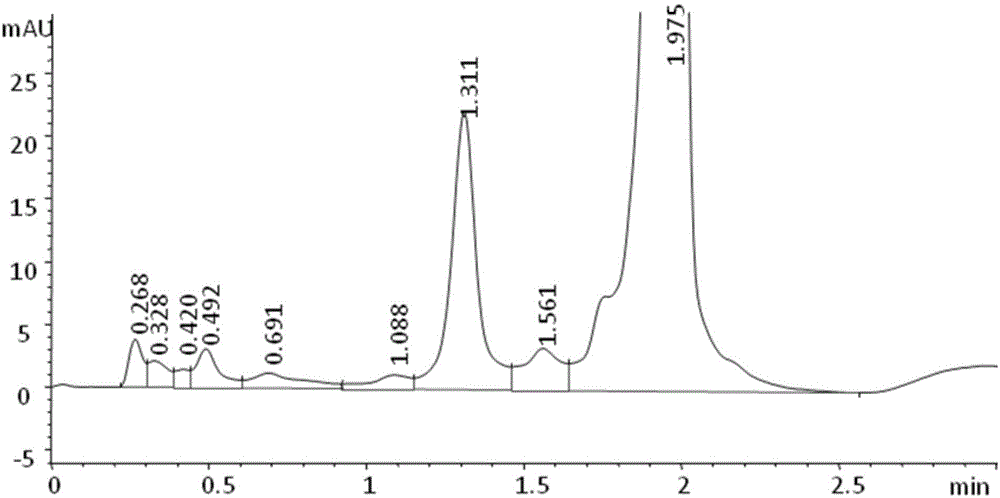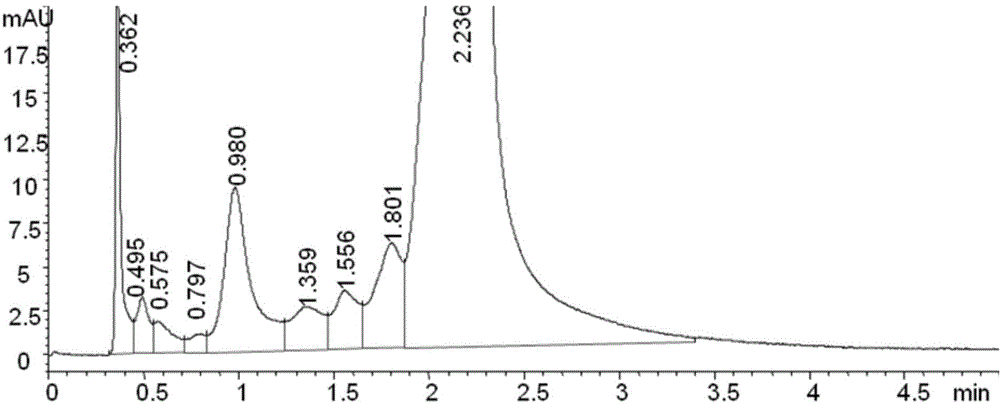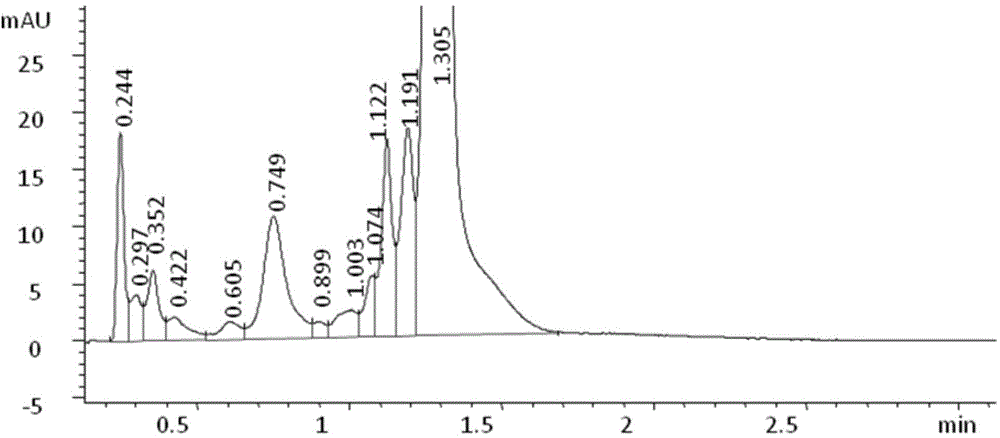Detection method for glycosylated hemoglobin and kit used in detection method
A glycosylated hemoglobin and detection kit technology, applied in the detection field, can solve the problems of inability to meet rapid quantitative detection, shortened chromatographic column life, inaccurate qualitative and quantitative detection, etc., and achieve the effect of prolonging life, good peak shape and efficient detection
- Summary
- Abstract
- Description
- Claims
- Application Information
AI Technical Summary
Problems solved by technology
Method used
Image
Examples
Embodiment 1
[0165] (1) Sample preparation: Accurately draw 10 μL of whole blood sample and dilute it with pure water, and the dilution factor is 200 times.
[0166] (2) Setting of chromatographic conditions:
[0167] a. Chromatographic column: GlyHb chromatographic column with a particle size of 5 μm and a column length of 4.6 X 50mm;
[0168] b. Column temperature: 40°C;
[0169] c. Mobile phase: A phase 50mM sodium phosphate buffer (pH 6.0), B phase A + 0.65M NaCl
[0170] d. Elution method two-phase gradient elution,
[0171] The elution gradient is: 0min~0.8min, the volume fraction of mobile phase B is from 5% to 12%;
[0172] 0.8min~1.5min The volume fraction of mobile phase B is from 12% to 80%;
[0173] 1.5min~1.8min The volume fraction of mobile phase B is from 80% to 100%;
[0174] 1.8min~2.1min The volume fraction of mobile phase B is from 100% to 5%.
[0175] e. Detection wavelength: 415nm;
[0176] f. Flow rate: 1.5mL / min;
[0177] g. Injection volume: 10 μL.
[0178]...
Embodiment 2
[0185] (1) Sample preparation: Accurately draw 10 μL of whole blood sample and dilute it with pure water, and the dilution factor is 200 times.
[0186] (2) Setting of chromatographic conditions:
[0187] a. Chromatographic column: GlyHb chromatographic column with a particle size of 10 μm and a column length of 4.6×50 mm;
[0188] b. Column temperature: 40°C;
[0189] c. Mobile phase: A phase 20mM citrate (pH 6.0) (0.02% NaN3); B phase A + 0.4M NaCl (0.02% NaN 3 )
[0190] d. Elution method: two-phase gradient:
[0191] The elution gradient is: 0min~1min, the volume fraction of mobile phase B is from 8% to 70%;
[0192] The volume fraction of mobile phase B is from 70% to 60% in 1min to 5min.
[0193] e. Detection wavelength: 415nm;
[0194] f. Flow rate: 1.5mL / min;
[0195]g. Injection volume: 10 μL.
[0196] h. Column pressure: 40bar
[0197] (3) Sample injection detection: send the diluted sample to high performance liquid chromatography for detection. Analysis r...
Embodiment 3
[0203] (1) Sample preparation: Accurately draw 10 μL of whole blood sample and dilute it with pure water, and the dilution factor is 200 times.
[0204] (2) Setting of chromatographic conditions:
[0205] a. Chromatographic column: GlyHb chromatographic column with a particle size of 5 μm and a column length of 4.6×50 mm;
[0206] b. Column temperature: 40°C;
[0207] c. Mobile phase: A phase: 50mM phosphate buffer + 25mM Tris (pH 6.0), B phase: A phase + 0.5M NaCl
[0208] d. Elution method: two-phase gradient elution
[0209] The elution gradient is: 0min~0.4min, the volume fraction of mobile phase B is from 6% to 15%;
[0210] 0.4min~0.6min The volume fraction of mobile phase B is from 15% to 28%;
[0211] The volume fraction of mobile phase B is from 28% to 100% in 0.6min to 1min.
[0212] e. Detection wavelength: 415nm;
[0213] f. Flow rate: 1.5mL / min;
[0214] g. Injection volume: 10 μL.
[0215] h. Column pressure: 60bar
[0216] (3) Sample injection detection...
PUM
| Property | Measurement | Unit |
|---|---|---|
| Particle size | aaaaa | aaaaa |
| Particle size | aaaaa | aaaaa |
| Column length | aaaaa | aaaaa |
Abstract
Description
Claims
Application Information
 Login to View More
Login to View More - R&D
- Intellectual Property
- Life Sciences
- Materials
- Tech Scout
- Unparalleled Data Quality
- Higher Quality Content
- 60% Fewer Hallucinations
Browse by: Latest US Patents, China's latest patents, Technical Efficacy Thesaurus, Application Domain, Technology Topic, Popular Technical Reports.
© 2025 PatSnap. All rights reserved.Legal|Privacy policy|Modern Slavery Act Transparency Statement|Sitemap|About US| Contact US: help@patsnap.com



